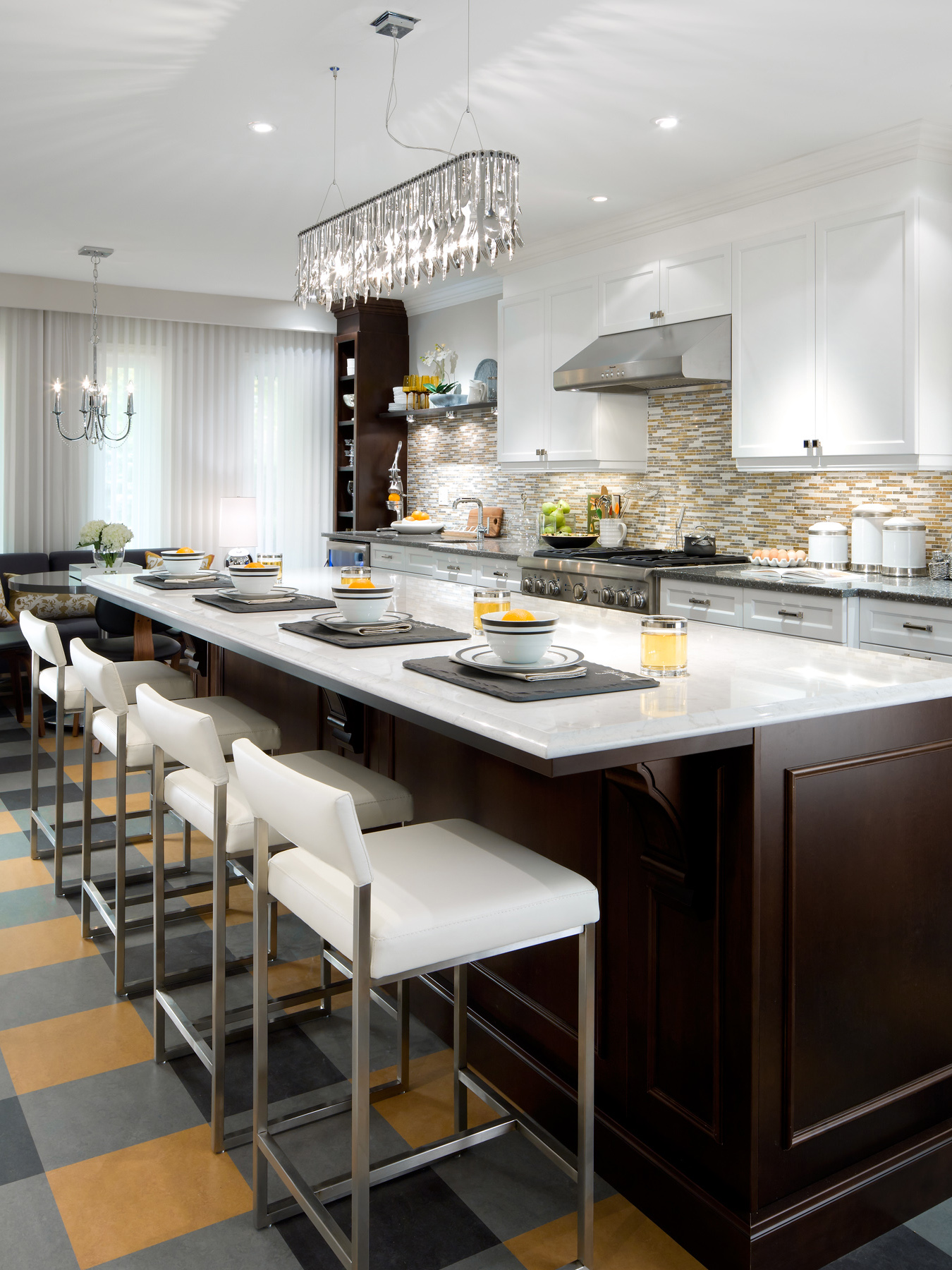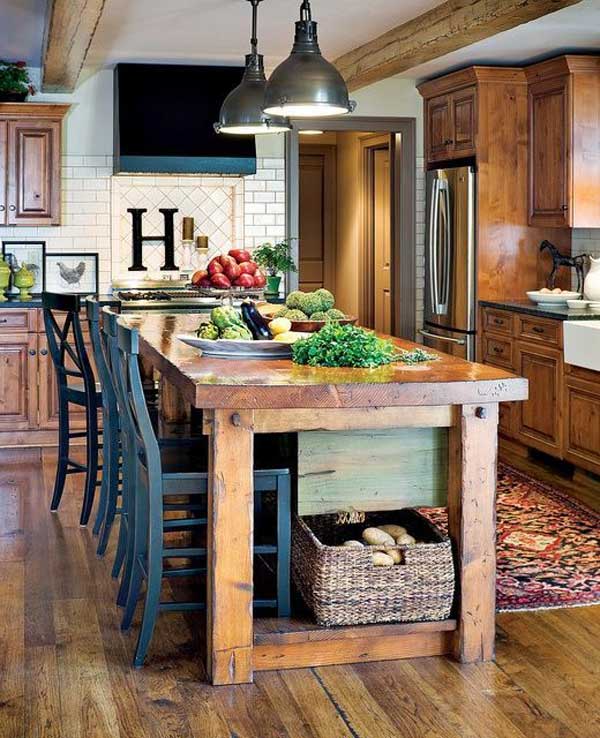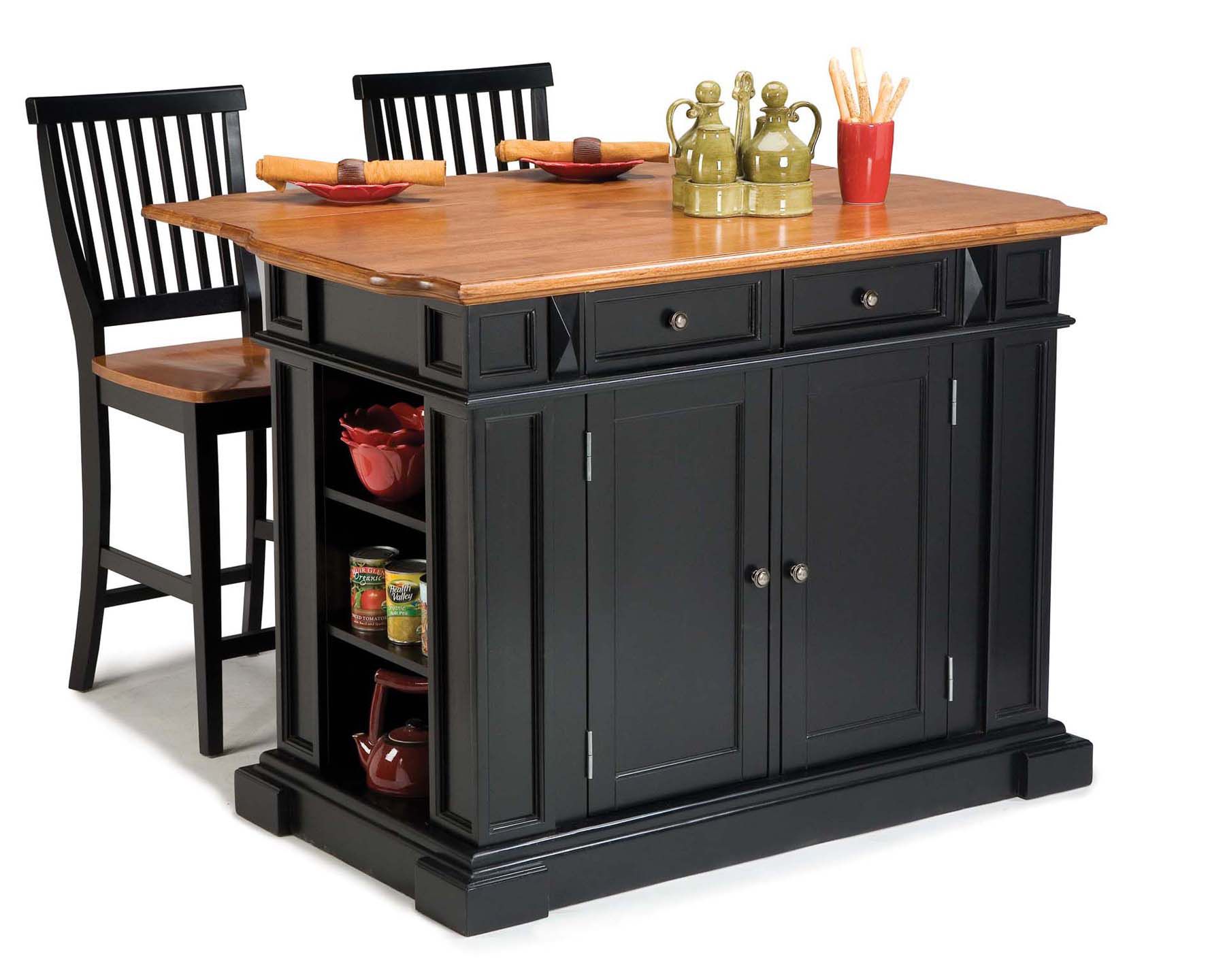A kitchen island with stools is more than just a functional piece of furniture; it’s a versatile centerpiece that enhances the aesthetic appeal and utility of a kitchen. This type of kitchen setup has gained popularity in recent years due to its ability to blend practicality with style. A kitchen island can serve as an additional workspace, a casual dining area, and even a social hub, all depending on how it’s designed and used. For families and individuals alike, the inclusion of stools makes it possible to transform the kitchen from a purely utilitarian space to one that invites interaction and relaxation. This combination provides a perfect setting for everything from morning coffee and breakfast with family to hosting casual dinners or gatherings.

The choice of stools is crucial in defining the overall look and functionality of a kitchen island. Stools come in various styles, including bar stools, counter stools, and swivel stools, each offering unique features. Bar stools are taller and typically suited for higher countertops, while counter stools are shorter and better for standard island heights. Swivel stools add an element of convenience, allowing easy movement and accessibility. The material and design of the stools also play a significant role in the kitchen’s aesthetics. Options range from sleek metal stools that offer a modern look to wooden stools that provide a rustic or traditional feel. Upholstered stools can add comfort and a touch of elegance, especially when they feature durable fabrics that are easy to clean.
The placement of a kitchen island with stools requires careful planning. Ideally, the island should be positioned to complement the kitchen’s workflow, ensuring that it doesn’t obstruct the path between the sink, stove, and refrigerator, commonly known as the kitchen work triangle. Adequate space around the island is essential to allow for movement and to avoid a cramped feeling. Designers often recommend leaving at least 36 to 48 inches of clearance around the island. This spacing ensures that there is enough room for people to walk around comfortably, even when the stools are in use. Additionally, the height of the island should be considered to the height of the stools, ensuring that the seating area is comfortable and accessible.

Lighting is another critical element when integrating a kitchen island with stools. Proper lighting not only enhances the functionality of the island but also contributes to the ambiance of the space. Pendant lights are a popular choice for illuminating kitchen islands. They provide focused light, which is ideal for tasks such as food preparation, and they also create a visual focal point. The style, size, and placement of these lights can vary, but they should be chosen to complement the overall design theme of the kitchen. Dimmers can be added to adjust the lighting according to different needs, from bright lighting for cooking to softer, ambient lighting for dining.
Storage solutions can significantly enhance the functionality of a kitchen island with stools. Many kitchen islands are designed with built-in storage options, such as cabinets, drawers, and shelves, which can be used to store kitchen essentials, cookbooks, and utensils. Some islands even feature wine racks or open shelving for decorative items. The addition of storage not only maximizes space but also keeps the kitchen organized and clutter-free. Islands with a combination of open and closed storage offer flexibility, allowing homeowners to display attractive items while keeping everyday essentials tucked away.

A kitchen island with stools can also serve as a multi-purpose area, doubling as a workspace or a spot for kids to do homework. This versatility makes it a valuable addition to any kitchen, especially in open-concept homes where the kitchen flows into other living spaces. The island can become a transitional element that connects the kitchen with the dining and living areas. This seamless integration fosters interaction and communication, allowing the cook to be part of the conversation and activities happening in the adjacent spaces.
Choosing the right materials for the island’s countertop is essential for both aesthetics and durability. Granite, quartz, and butcher block are popular choices, each offering distinct advantages. Granite is known for its durability and resistance to heat, making it ideal for heavy-use areas. Quartz offers a wide range of colors and patterns, and it’s resistant to stains and scratches, requiring minimal maintenance. Butcher block countertops bring warmth and a natural look to the kitchen, although they require regular sealing to protect against water and stains. The choice of material should reflect the homeowner’s lifestyle, ensuring that the countertop can withstand daily wear and tear.
Incorporating a sink or a cooktop into a kitchen island with stools can further enhance its functionality. A sink can make the island a convenient spot for food preparation and cleanup, especially if it includes a garbage disposal or a pull-out faucet. A cooktop allows the cook to face guests while preparing meals, creating an interactive cooking experience. Both options require careful planning to accommodate plumbing and electrical needs, but they can significantly improve the kitchen’s efficiency and layout. These features are especially beneficial in larger kitchens where the island can serve as a secondary cooking or prep area.

The style of the kitchen island should complement the overall design of the kitchen. For a modern kitchen, a sleek island with clean lines and minimalist stools can create a cohesive look. In contrast, a traditional kitchen might feature a more ornate island with carved details and classic stools. Coastal-themed kitchens often incorporate light-colored islands with beadboard detailing and stools made from natural materials like rattan or wicker. The choice of color can also make a statement; a bold, contrasting color for the island can serve as an eye-catching focal point, while a more subdued color can create a harmonious and calming effect.
Comfort is a key consideration when selecting stools for a kitchen island. Upholstered seats, backrests, and footrests can make the stools more comfortable, encouraging guests and family members to linger. The height of the stools should be appropriate for the island’s countertop height, typically 24 to 26 inches for counter-height stools and 28 to 30 inches for bar-height stools. Adjustable height stools offer flexibility, allowing them to be used at different heights and by people of varying heights. Swivel stools also add convenience, making it easier to get on and off the stools and to turn towards different areas of the kitchen or living space.
The incorporation of a kitchen island with stools can also enhance the resale value of a home. Potential buyers often view the kitchen as one of the most important rooms in a home, and a well-designed kitchen island can make a strong positive impression. It showcases the kitchen’s functionality and style, making it more attractive to buyers who value both aesthetics and practicality. An island with ample seating and storage can appeal to families, while an island with a sleek design and modern features can attract younger buyers or those looking for a contemporary living space.
In smaller kitchens, a kitchen island with stools can be designed to maximize space without overwhelming the room. Compact islands with space-saving features, such as fold-out leaves or pull-out extensions, provide additional workspace and seating when needed while retracting to save space when not in use. Mobile islands on wheels offer flexibility, allowing homeowners to move the island as needed to create more space or to use it as a serving cart during gatherings. The choice of stools can also impact the space; backless stools can be tucked under the island when not in use, freeing up floor space.
For homeowners who enjoy entertaining, a kitchen island with stools provides an ideal setting for casual dining and socializing. Guests can sit comfortably on the island while enjoying drinks and appetizers, allowing the host to interact with them while preparing food. The island can also serve as a buffet station, with ample space for serving dishes and beverages. This setup creates a relaxed and inviting atmosphere, making the kitchen the heart of social gatherings. The versatility of the island allows it to adapt to different occasions, from intimate family dinners to large parties.
The color and finish of the stools can significantly impact the overall look of the kitchen. Stools with metal finishes can add a modern and industrial touch, while wooden stools bring warmth and a natural element. Painted stools offer an opportunity to introduce color and personality into the kitchen, either by matching the island’s color or by creating a contrasting pop of color. Cushions and seat covers can be used to add comfort and style, with options ranging from simple and understated to bold and patterned. The choice of stools should reflect the kitchen’s design theme and the homeowner’s style.
Last, the use of a kitchen island with stools can promote a healthier lifestyle by encouraging more home-cooked meals and family time. With a functional and inviting kitchen space, cooking becomes more enjoyable, and family members are more likely to gather in the kitchen. The island provides a convenient spot for children to do homework while parents prepare meals, fostering communication and bonding. For those who work from home, the island can serve as a temporary workstation, offering a change of scenery from the home office. The versatility and appeal of a kitchen island with stools make it a valuable addition to any home.

Common Mistakes to Avoid
One common mistake when incorporating a kitchen island with stools is failing to consider the space requirements. Insufficient clearance around the island can lead to a cramped and uncomfortable kitchen layout, making it difficult for people to move around freely. It’s essential to measure the available space and plan the island’s placement accordingly.
Another mistake is choosing the wrong stool height for the island’s countertop. Stools that are too high or too low can be uncomfortable to sit on, so it’s important to select stools that match the height of the island.
Additionally, overlooking the importance of lighting can result in a less functional and less inviting space. Proper lighting is crucial for both tasks and ambiance, so incorporating adequate lighting fixtures is essential.
Last, not considering the island’s material and finish to the overall kitchen design can lead to a mismatched look. The island and stools should complement the kitchen’s style and color scheme to create a cohesive and harmonious appearance.

What height should kitchen island stools be?
Kitchen island stools typically come in two standard heights: counter height and bar height. Counter-height stools, which are usually 24 to 26 inches tall, are ideal for islands with standard countertops that are about 36 inches high. Bar-height stools, which are around 28 to 30 inches tall, are suitable for higher countertops, typically 42 inches high. It’s important to choose stools that provide a comfortable seating position, with enough space for legs under the countertop.
How many stools can fit on a kitchen island?
The number of stools that can fit on a kitchen island depends on the island’s length and the width of the stools. A general guideline is to allow 24 inches of space per stool, which provides enough room for people to sit comfortably and move their stools without feeling cramped. For example, a 6-foot-long island can typically accommodate three stools, while a longer island might fit four or more.
What are the best materials for kitchen island stools?
The best material for kitchen island stools depends on the kitchen’s style and the desired level of durability and comfort. Metal stools are durable and easy to clean, making them suitable for modern and industrial kitchens. Wooden stools offer warmth and a traditional look, while upholstered stools provide added comfort, especially for extended seating. Consider the kitchen’s overall design and the level of maintenance required when choosing materials.

Can a kitchen island with stools replace a dining table?
Yes, a kitchen island with stools can replace a dining table, especially in smaller homes or open-concept spaces where maximizing space is important. The island can serve as a casual dining area for everyday meals and even for entertaining guests. However, it’s important to ensure that the island has enough seating and space to accommodate the household’s dining needs, as well as a design that makes it comfortable for dining.
How do I choose the right style of stools for my kitchen island?
Choosing the right style of stools for a kitchen island involves considering the kitchen’s overall design theme and the desired look. For a modern kitchen, sleek and minimalist stools with clean lines work well. In contrast, traditional kitchens may benefit from stools with more ornate designs and classic details. Coastal or rustic kitchens can incorporate stools made from natural materials like wood or wicker. The color and finish of the stools should complement the kitchen’s color scheme, and comfort features such as cushioned seats and backrests can enhance the seating experience.
Is it necessary to have lighting above the kitchen island with stools?
Yes, having lighting above the kitchen island with stools is highly recommended. Proper lighting enhances the functionality of the island, making it easier to perform tasks such as food preparation and dining. Pendant lights are a popular choice for kitchen islands, as they provide focused light and can serve as a decorative element. The lighting should be bright enough for tasks but also adjustable to create different moods, making the island a versatile and inviting space.

Barrington Oak Stool Grey Fabric Oak stool

Must-See Practical Kitchen Island Designs With Seating

Island with two levels Kitchen bar, Kitchen island with sink

Related Posts:
- Kitchen Island Designs With Sink And Dishwasher
- Yummy Kitchen Warwick Rhode Island
- Monarch Kitchen Island Set
- Craigslist Long Island Kitchen Cabinets
- Large Eat In Kitchen Island
- Lime Green Kitchen Island
- Wicker Kitchen Island Chairs
- Slim Kitchen Island With Seating
- Industrial Lighting Over Kitchen Island
- Building Kitchen Island Bar
